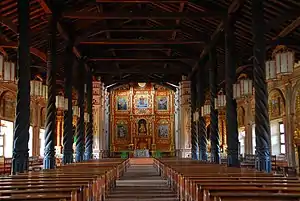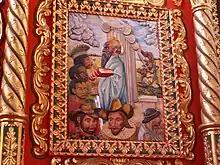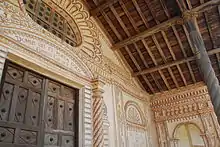Jesuit reduction
The Jesuit reductions were a type of settlement for indigenous people specifically in the Rio Grande do Sul area of Brazil, Paraguay and neighbouring Argentina in South America, established by the Jesuit Order early in the 17th century and wound up in the 18th century with the banning of the Jesuit order in several European countries.[1] Subsequently it has been called an experiment in "socialist theocracy" or a rare example of "benign colonialism".

Part of a series on |
| Spanish missions in the Americas of the Catholic Church |
|---|
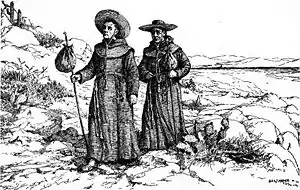 |
| Missions in North America |
| Missions in South America |
| Related topics |
|
|
In their newly acquired South American dominions the Spanish and Portuguese Empires had adopted a strategy of gathering native populations into communities called "Indian reductions" (Spanish: reducciones de indios) and Portuguese: "redução" (plural "reduções"). The objectives of the reductions were to impart Christianity and European culture.[2] Secular as well as religious authorities created "reductions".
The Jesuit reductions were Christian missions that extended successfully in an area straddling the borders of present-day Paraguay, Brazil, and Argentina (the triple frontera) amongst the Guarani peoples. The reductions are often called collectively the Rio de la Plata missions. The Jesuits attempted to create a "state within a state" in which the native peoples in the reductions, guided by the Jesuits, would remain autonomous and isolated from Spanish colonists and Spanish rule.[3] A major factor attracting the natives to the reductions was the protection they afforded from enslavement and the forced labour of encomiendas.
Under the leadership of both the Jesuits and native caciques, the reductions achieved a high degree of autonomy within the Spanish colonial empire. With the use of native labour, the reductions became economically successful. When the incursions of Brazilian Bandeirante slave-traders threatened the existence of the reductions, Indian militias were set up which fought effectively against the Portuguese colonists.[3] However, directly as a result of the Suppression of the Society of Jesus in several European countries, including Spain, in 1767, the Jesuits were expelled from the Guaraní missions (and the Americas) by order of the Spanish king, Charles III. So ended the era of the Paraguayan reductions. The reasons for the expulsion related more to politics in Europe than the activities of the Jesuit missions themselves.[4]
The Jesuit Rio de la Plata reductions reached a maximum population of 141,182 in 1732 in 30 missions in Brazil, Paraguay, and Argentina. The reductions of the Jesuit Missions of Chiquitos in eastern Bolivia reached a maximum population of 25,000 in 1766.[5] Jesuit reductions in the Llanos de Moxos, also in Bolivia, reached a population of about 30,000 in 1720.[6] In Chiquitos the first reduction was founded in 1691 and in the Llanos de Moxos in 1682.
The Jesuit reductions have been lavishly praised as a "socialist utopia"[7] and a "Christian communistic republic" as well as criticized for their "rigid, severe and meticulous regimentation" of the lives of the Indian people they ruled with a firm hand through Guaraní intermediaries.[8]
History
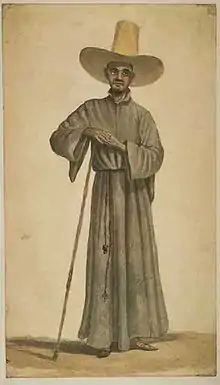
In the 16th century, priests of different religious orders set out to evangelize the Americas, bringing Christianity to indigenous communities. The colonial governments and missionaries agreed on the strategy of gathering the often nomadic indigenous populations in larger communities called reductions in order to more effectively govern, tax, and evangelize them. Reductions generally were also construed as an instrument to make the Indians adopt European lifestyles and values.[3] In Mexico the policy was called congregación, and also took the form of the hospitals of Vasco de Quiroga and the Franciscan Missions of California. In Portuguese Brazil reductions were known as aldeias. Legally, under colonial rule, Indians were classified as minors, in effect children, to be protected and guided to salvation (conversion to Christianity) by European missionaries.[3]
The Jesuits, formally founded only in 1540,[9] were relatively late arrivals in the New World, from about 1570, especially compared to the Dominicans and Franciscans, and therefore had to look to the frontiers of colonization for mission areas.[10] The Jesuit reductions originated in the early seventeenth century when Bishop Lizarraga asked for missionaries for Paraguay. In 1609, acting under instructions from Phillip III, the Spanish governor of Asunción made a deal with the Jesuit Provincial of Paraguay.[11] The Jesuits agreed to set up hamlets at strategic points along the Paraná river, that were populated with Indians and maintained a separation from Spanish towns.[11] The Jesuits were to "enjoy a tax holiday for ten years" which extended longer.[11] This mission strategy continued for 150 years until the Jesuits were expelled in 1767. Fundamentally the purpose, as far as the government was concerned, was to safeguard the frontier with the reductions where Indians were introduced to European culture.[11][12]

Failure and flight
In 1609 three Jesuits began the first reduction in San Ignacio Guazú in present-day Paraguay. For the next 22 years the Jesuits focused on founding 15 missions in the province of Guayrá, corresponding to the western two-thirds of present-day Paraná state of Brazil, spread over an area of more than 100,000 square kilometres (39,000 sq mi).[13] The total Native population of this area was probably about 100,000.[14]
The establishment of these missions was not without difficulty and danger. The Guaraní shamans resisted the imposition of a new religion and up to 7 Jesuits were killed by Indians during the first few years after the missions were established.[15] In 1618 began the first of a series of epidemics that would spread among the missions and kill thousands of the Guaraní. The congregation of the Guaraní into large settlements at the missions facilitated the spread of disease.[16] Nevertheless, the missions soon had 40,000 Guaraní in residence.[17] However, tens of thousands of Guaraní living in the same region remained outside the missions, living in their traditional manner and practicing their traditional religion.
The reductions were within Portuguese territory and large-scale raids by the Bandeirante slavers of Sao Paulo on the missions and non-mission Guarani began in 1628. The Bandeirantes destroyed many missions and decimated and scattered the mission population. They looked upon the reductions with their concentration of Guaraní as an opportunity to capture slaves more easily than usual. Beginning in 1631 and concluding in 1638 the Jesuits moved the mission survivors still in residence, approximately 12,000 people, southwestward about 500 kilometres (310 mi) to an area under Spanish control that in the 21st century is divided among Paraguay, Argentina, and Brazil. [18] There were already Jesuit missions in the area and the refugees from Guayrá were joined also by Guarani refugees from Uruguay and Tapé (Rio Grande do Sul state of Brazil) who had suffered similar experiences.[19]
Reestablishment and success
At the new locations, the Jesuits would establish 30 reductions, collectively often called the Rio de la Plata missions. By 1641, despite slavers and epidemics, the Guarani population of the Rio de la Plata missions was 36,190. For nearly a century thereafter, the mission population would steadily increase to a maximum of 141,242 in 1732.[20]
The immediate need of the Guarani in the 1640s was to protect themselves from slavers. The Jesuits began to arm them, producing guns and gunpowder in the missions.[21] They also secured the Spanish Crown's permission, and some arms, to raise militias of Indians to defend the reductions against raids. The bandeirantes followed the reductions into Spanish territory but in 1641 the Guaraní militia defeated an army of 1,500 or more Portuguese slavers and Tupi Indian auxiliaries in the battle of Mbororé.[3] The militias would eventually number as many as 4,000 troops and their cavalry was especially effective, wearing European-style uniforms and carrying bows and arrows as well as muskets.
Over a century passed until, in the Treaty of Madrid (1750), the Spanish ceded to the Portuguese territories including the Misiones Orientales, reductions now in Brazil, threatening to expose the Indians again to the more oppressive Portuguese system. The Jesuits complied, trying to relocate the population across the Uruguay river as the treaty allowed, but the Guaraní militia under the mission-born Sepé Tiaraju resisted in the Guaraní War, and defeated Spanish troops, obliging them in 1754 to sign an armistice in Guaraní – a victory that helped to ensure the eventual defeat of the reductions. What came to be known as the War of the Reductions ended when a larger force of 3,000 combined Spanish and Portuguese troops crushed the revolt in 1756, with Guaraní losses (both in battle and subsequent massacres) of over 1,500.[22]
The reductions came to be considered a threat by the secular authorities and were caught up in the growing attack on the Jesuits in Europe for unrelated reasons. The economic success of the reductions, which was considerable although not as great as often described, combined with the Jesuits' independence, became a cause of fear. The reductions were considered by some philosophies as ideal communities of noble savages, and were praised as such by Montesquieu in his L'Esprit des Lois (1748), and even by Rousseau, no friend of the church.[23] Their intriguing story has continued to be the subject of some romanticizing, as in the film The Mission (1986) whose story relates to the events of the 1750s shown on a miniature scale.
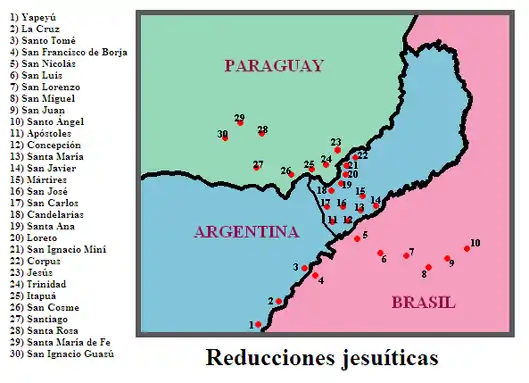
Expulsion
When the Jesuits were expelled from the Spanish realm in 1767, the reductions slowly died out, becoming victims of slave raids or being absorbed into European society. Some of the reductions have continued to be inhabited as towns while most have been abandoned and remain only as ruins. Córdoba, Argentina, the largest city associated with the reductions, was atypical as a Spanish settlement that predated the Jesuits and functioned as a centre for the Jesuit presence, with a novitiate centre and a college that is now the local university. The Córdoba mission was taken over by the Franciscans in 1767. Many have been declared UNESCO World Heritage sites, including six of the Jesuit Missions of Chiquitos in Bolivia, and others in Brazil, Argentina, and Paraguay. There are also two creole languages, Língua Geral and Nheengatu, originating in the reductions and based on Guaraní, Tupi, and Portuguese.
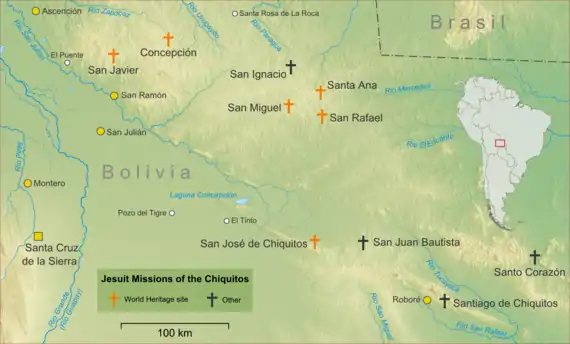
Other reductions
The Jesuit success in the Rio de la Plata, Chiquitos, and Llanos de Moxos missions was not duplicated by missions among the populous and warlike Eastern Bolivian Guarani or Chiriguanos of the Andes foothills. A Jesuit mission amongst the Chiriguanos in 1767 had only 268 converts.[24]
Likewise, the Jesuits had little success among the Guaycuru peoples, several nomadic tribes who dominated the Gran Chaco
Mission life

At the height of the reductions in the 18th century were around 40 different communities that were home to more than 150,000 Indians, most of whom were Guaraní, Tupi, Chiquitos, and members of diverse ethnic groups in the Llanos de Moxos.
Reductions were laid out according to a standardised plan: the main buildings, like the church, college and churchyard were concentrated around a wide square, with houses facing the other three sides. Each village also provided a house for widows, a hospital, and several warehouses. In the centre of the square there was a cross and a statue of the mission's patron saint. The reductions were ruled by indigenous chiefs who served as the reductions' governors, but were controlled by the Jesuits. There was a minimum of two Jesuits in a reduction, with more for larger ones. The social organization of the reductions has often been described as extremely efficient; most were self-supporting and even produced surpluses of goods, which they traded to outside communities, which laid the foundation of the belief that Jesuits were guarding immense riches acquired through Indian labour. The main traded produce was the hides of their cattle and yerba mate, leaves drunk somewhat like tea. Initially these were collected from the wild, but later cultivated. A number of trades and skills were taught to some Indians, including even printing to produce mostly religious texts in indigenous languages, some illustrated by engravings by indigenous artists.[25] In reality the communities were economically successful but hardly constituted any important source of income for the Jesuit order.[3] The degree to which the Jesuits controlled the indigenous population for which they had responsibility and the degree to which they allowed indigenous culture to function is a matter of debate.[3]

The main buildings, especially the churches, were often substantial Baroque constructions made by trained indigenous craftsmen and often remain impressive after over two centuries of abandonment, though the elaborate carved wood interiors have vanished in these cases. The first buildings were usually made in wood, which was sometimes covered with stucco decoration imitating stone Baroque architecture. Later, if resources allowed, actual stone buildings would follow, sometimes very large. The Bolivian missions have the best surviving wood and adobe churches. Father Martin Schmid (1694–1772), a Swiss Jesuit who was a leading figure in the reductions, was both an architect and a composer, and is usually given much of the credit for both the later architecture and the remarkable musical life of the reductions.[26]
Mission layout
The ruins of several of the missions still remain. They were laid out in a uniform plan. The buildings were grouped about a central square, the church and store-houses at one end, and the dwellings of the natives, in long barracks, forming the other three sides. Each family had its own separate apartment, but one veranda and one roof served for perhaps a hundred families. The churches were of stone or fine wood, with lofty towers, elaborate sculptures and richly adorned altars, with statuary imported from Italy and Spain. The priests' quarters, the commissary, the stables, the armory, the workshop, and the hospital, also usually of stone, formed an inner square adjoining the church. The plaza itself was a level grass plot kept cropped by sheep. The native houses were sometimes of stone but more often of adobe or cane, with home-made furniture and religious pictures often made by the natives themselves.
Life at the missions
Smaller missions had two priests, whereas larger missions had more. Populations varied from 2,000 to 7,000. In the morning, children's hymns were followed by Mass and breakfast, after which the workers went to their tasks.
The Jesuits marshaled their neophytes to the sound of music, and in procession to the fields, with a saint borne high aloft, the community each day at sunrise took its way. Along the way at stated intervals were shrines of saints where they prayed, and sang hymns between shrines. As the procession advanced it became gradually smaller as groups of Indians dropped off to work the various fields and finally the priest and acolyte with the musicians returned alone.[27]:178f
At noon each group assembled for the Angelus, after which came dinner and a siesta; work was then resumed until evening. After supper came the rosary and sleep. On rainy days they worked indoors. Frequent festivals with sham battles, fireworks, concerts, and dances enlivened the community.
Aside from the main farm, each man typically had his own garden, pursuing agriculture, stock raising, and the cultivation of maté. Jesuits introduced many European trades and arts to their communities. Cotton weavers, tanners, carpenters, tailors, hat makers, coopers, boat builders, silversmiths, musicians and makers of musical instruments, painters, and turners could sometimes be found. They also had printers, and manuscripts were also produced by hand copying.[27]
The goods that were produced at the missions, including cattle, were sold in Buenos Aires and other markets under the supervision of the priests. The proceeds earned were divided among a common fund, the workers, and dependents.
Much emphasis was placed on education, as early training was regarded as the key to future success.[27]:503 Much of the instruction was conducted in Guaraní, which was still the prevailing language of the country, but Spanish was also taught.
| Year | Population | Comments |
|---|---|---|
| 1641 | 36,190 | |
| 1700 | 86,173 | Steady growth since 1647 |
| 1732 | 141,242 | Largest population of reductions |
| 1740 | 73,910 | Reduced population due to epidemics |
| 1768 | 88,864 | Jesuits expelled |
| 1801 | 45,637 | Reductions in decline |
Jesuit reductions by country
Argentina
- San Ignacio Mini in Misiones Province
- Nuestra Señora de Santa Ana in Misiones Province
- Nuestra Señora de Loreto in Misiones Province
- Santa María la Mayor in Misiones Province
- Jesuit Block and Estancias of Córdoba in Córdoba
Bolivia

Brazil
- São Miguel das Missões
- São João Batista
- São Lorenço Martir
- São Nicolau
- São Francisco de Borgia
- São Luis Gonzaga
- Santo Ângelo Custódio
Paraguay
Uruguay
- Nuestra Señora de los Desamparados, on the coast of Santa Lucia River.
- Estancia del Rio de las Vacas, founded in 1741 and known today as "Calera de las Huérfanas", in Colonia Department near Carmelo
Gallery

See also
References
Footnotes
- "Reductions of Paraguay | Encyclopedia.com". www.encyclopedia.com. Retrieved 2020-09-03.
- Caraman Philip. SJ (1975). The Lost Paradise - The Jesuit Republic in South America. London: Sidgwick & Jackson. ISBN 9780283982125.
- Lippy, Charles H, Robert Choquette and Stafford Poole (1992). Christianity comes to the Americas: 1492–1776. New York: Paragon House. pp. 98–100. ISBN 978-1-55778-234-2.CS1 maint: multiple names: authors list (link)
- Roehner, Bertrand M. (April 1997), "Jesuits and the State: A Comparative Study of their Expulsions (1590–1990)", Religion, 27 (2): 165–182, doi:10.1006/reli.1996.0048
- Ganson, p. 53
- Block, David (1994), Mission Culture on the Upper Amazon, Lincoln: University of Nebraska Press, p. 11
- Gott, Richard (1993), Land Without Evil: Utopian Journeys Across the South American Watershed, London: Verso, p. 8
- Crocitti, John J. (2002), "The Internal Economic Organizations of the Jesuit Missions among the Guarani", International Social Science Review, Vol. 77, No. 1/2, p.3. Downloaded from JSTOR
- Ganson, 31
- Bakewell, 258
- Gott, 29
- Ganson, 35
- Ganson, (map) p. 32
- Saloman, Frank and Schwarts, Stuart B., eds. (1996), The Cambridge History of the Native Peoples of the Americas, Volume 3, Part 2, Cambridge: Cambridge University Press, p. 25
- Ganson, p. 38
- Jackson, Robert H. (2015), Demographic Change and Ethnic Survival among the Sedentary Populations on the Jesuit Mission Frontiers of Spanish South America, 1609-1803 Boston: BRILL, p. 63
- Catholic Encyclopedia (1913)/Guaraní Indians,https://en.wikisource.org/wiki/Catholic_Encyclopedia_(1913)/Guaran%C3%AD_Indians, accessed 25 Oct 2017
- Catholic Encyclopedia, Ganson pp. 42-46
- Jackson, Robert H., "A Survey of Demographic Patterns in the Jesuit Missions of Paraguay", http://www.casahistoria.net/rhjackson6.htm, accessed 26 Oct 2017
- Jackson,"A Survey of Demographic Patterns...", http://www.casahistoria.net/rhjackson6.htm, accessed 26 Oct 2017
- Sarreal, Julia J. S. (2014), The Guaraní and their Missions, Stanford: Stanford University Press, pp 32-33
- de Ventos, 48
- Haase, 412
- Langer, Erick D. (2009), Expecting Pears from an Elm Tree,, Durham: Duke University Press, pp. 15-16
- Bakewell, 259
- Martin Schmid, architect and musician.
- Graham
- Jackson, Robert H, "Power, Population, and the Colonizations of the Fringes of Spanish America," http://www.casahistoria.net/rhjackson2.htm, accessed 5 Dec 2017
Bibliography
- Bakewell, Peter John, A history of Latin America: c. 1450 to the present, 2nd edn, 2004, Wiley-Blackwell, ISBN 0-631-23160-9, ISBN 978-0-631-23160-8, google books
- Bailey, Gauvin Alexander. Art on the Jesuit Missions in Asia and Latin America, 1999.
- Caraman, Philip (1976). The lost paradise: the Jesuit Republic in South America. New York: Seabury Press. ISBN 978-0-8164-9295-4.
- Graham, R.B. Cunninghame (1924). A Vanished Arcadia: Being Some Account of the Jesuits in Paraguay 1607 to 1767 (etext). London: William Heinemann. ISBN 978-0-7126-1887-8.
- Ganson, Barbara (2003). The Guarani under Spanish Rule in the Rio de la Plata. Stanford University Press. ISBN 978-0-8047-5495-8.
- Gott, Richard (1993). Land Without Evil: Utopian Journeys Across the South American Watershed (illustrated ed.). Verso. p. 202. ISBN 978-0-86091-398-6. Retrieved 2010-03-10.
- Haase, Wolfgang, and Meyer Reinhold (eds.) (1994). The Classical Tradition and the Americas. ISBN 9783110115727.CS1 maint: extra text: authors list (link)
- Lippy, Charles H, Robert Choquette and Stafford Poole (1992). Christianity comes to the Americas: 1492 - 1776. New York: Paragon House. ISBN 978-1-55778-234-2.CS1 maint: multiple names: authors list (link)
- McNaspy, Clement J. (1984). Conquistador without sword. The life of Roque González, S.J. Chicago: Loyola University Press.
- Nonneman, Walter. "On the Economics of the Socialist Theocracy of the Jesuits in Paraguay", from The Political Economy of Theocracy, ISBN 978-0230613102.
- de Ventós, Xavier Rubert, The Hispanic labyrinth: tradition and modernity in the colonization of the Americas, Transaction Publishers, 1991, ISBN 978-0-88738-301-4.
External links
| Wikimedia Commons has media related to Jesuit Reductions. |
- Article by Alan Rinding on Brazil's Indians
- Indigenous Genocide in the Brazilian Amazon
- In-depth 1913 Catholic Encyclopedia article on the Reductions
- Colonial Brazil: The Portuguese, the Tupi, and other indigenous tribes
- Detailed description of the Jesuit reductions in Chiquitanía with pictures
- A Current Description of the Province of the Society of Jesus in Paraguay with Neighboring Areas, 1732, World Digital Library
- The Jesuit Missions of Paraguay, Argentina, and Brazil Robert H. Jackson
